A latte is one of the most popular coffee beverages around, often enjoyed for its smooth, creamy texture and rich flavor. But what exactly goes into making this delightful drink and does a latte have espresso? At its core, a latte consists of three main components: espresso, steamed milk, and a small layer of milk foam.
The word “latte” comes from the Italian phrase “caffè latte,” which means “milk coffee.” This name perfectly captures the essence of the drink, as it primarily features a generous amount of steamed milk mixed with a shot (or two) of robust espresso. The espresso provides the strong coffee flavor, while the steamed milk adds a creamy texture, and the milk foam on top offers a velvety finish.

What is a Latte?
A latte, short for “caffè latte,” is a popular coffee beverage known for its creamy texture and balanced flavor. This drink is typically made with one or two shots of espresso and a generous amount of steamed milk, topped with a small layer of milk foam. The espresso gives the latte its strong coffee taste, while the steamed milk creates a smooth, mellow finish.
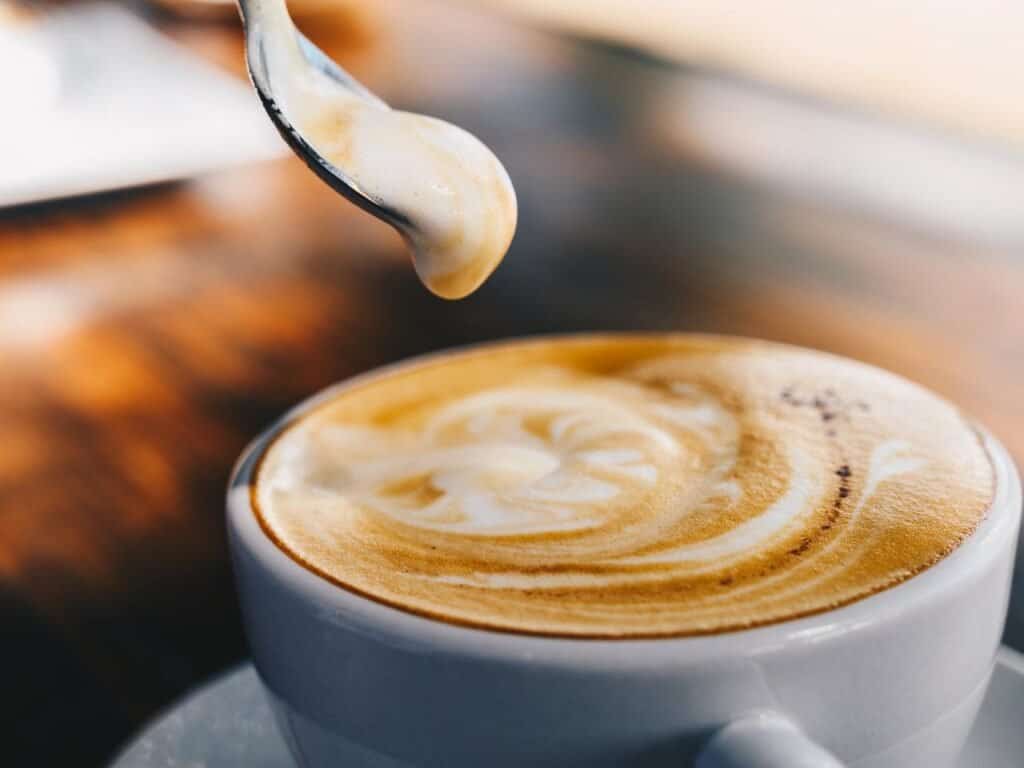
History and Origin
The latte’s origins can be traced back to Italy, where it was traditionally served as a breakfast drink. The term “caffè latte” means “milk coffee” in Italian, and it was a staple in Italian households long before it gained global popularity. The beverage made its way to the United States in the 1980s, where it quickly became a favorite among coffee enthusiasts.
Cultural Significance
In many cultures, the latte has become more than just a drink—it’s a part of the daily routine and a social experience. Coffee shops around the world serve lattes as a comforting, indulgent treat, often enjoyed during a morning break or an afternoon catch-up with friends. The latte’s versatility also allows for various flavorings and customizations, making it a favorite for those who enjoy personalizing their coffee experience.
Key Ingredients of a Latte
To understand what makes a latte so special, it’s essential to look at its key components. A traditional latte consists of three main ingredients: espresso, steamed milk, and milk foam. Each plays a vital role in creating the perfect balance of flavors and textures.
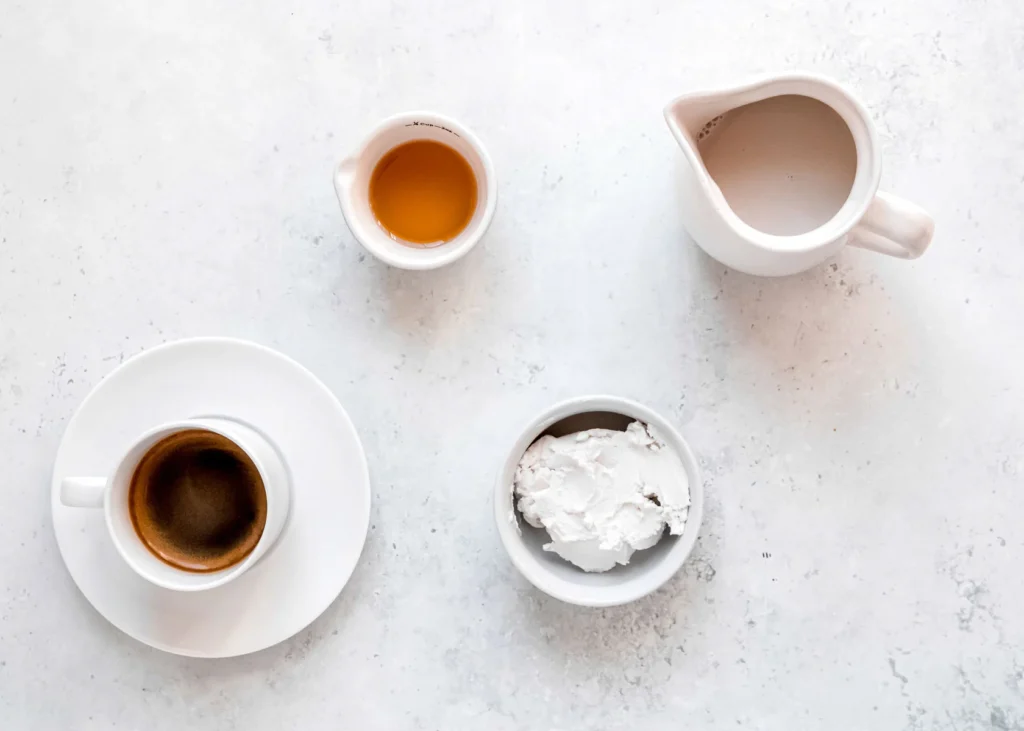
- Espresso: At the heart of every latte is a shot (or two) of espresso. This strong, concentrated coffee is brewed by forcing hot water through finely-ground coffee beans. The result is a rich, intense flavor that serves as the backbone of the latte. The espresso provides the bold coffee taste that is both robust and smooth, forming the essential base upon which the other ingredients build.
- Steamed Milk: Steamed milk is the second crucial component of a latte. Milk is heated using a steam wand, creating a creamy, velvety texture. This process not only warms the milk but also incorporates tiny bubbles, giving it a light, frothy consistency. The steamed milk balances the strength of the espresso, adding sweetness and creaminess that make the latte so enjoyable.
- Milk Foam: The final touch on a latte is a thin layer of milk foam. This foam is created by continuing to steam the milk until it becomes light and airy. The foam is then carefully spooned on top of the latte, adding a luxurious texture and a visually appealing finish. The milk foam also helps to retain the warmth of the drink, ensuring each sip is as delightful as the last.
Espresso in Lattes
Espresso is the foundation of a latte, playing a crucial role in defining its flavor and character. But what exactly is espresso, and why is it so important in a latte?
What is Espresso?
Espresso is a concentrated form of coffee made by forcing hot water through finely-ground coffee beans under high pressure. This brewing method extracts the rich, intense flavors and aromatic compounds of the coffee, resulting in a small but powerful shot of coffee. Unlike regular drip coffee, espresso has a thicker consistency and a robust, full-bodied taste.
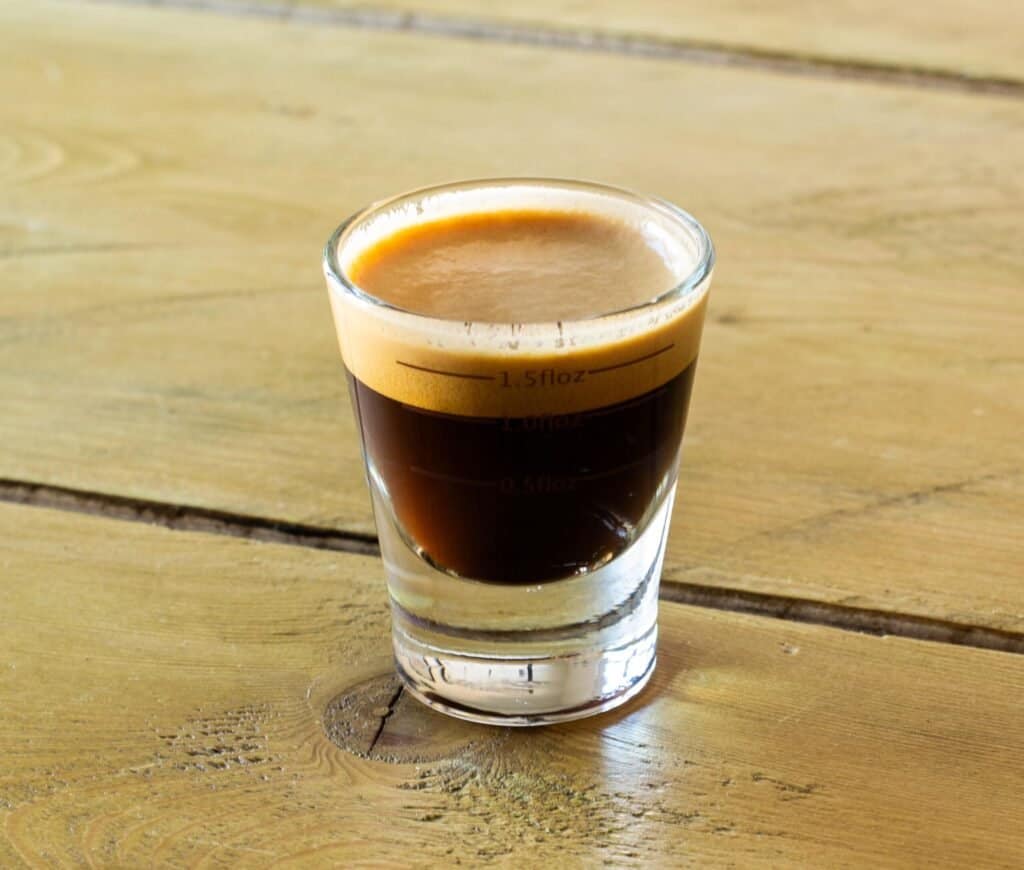
Importance of Espresso in Lattes
The role of espresso in a latte cannot be overstated. Here’s why it’s so essential:
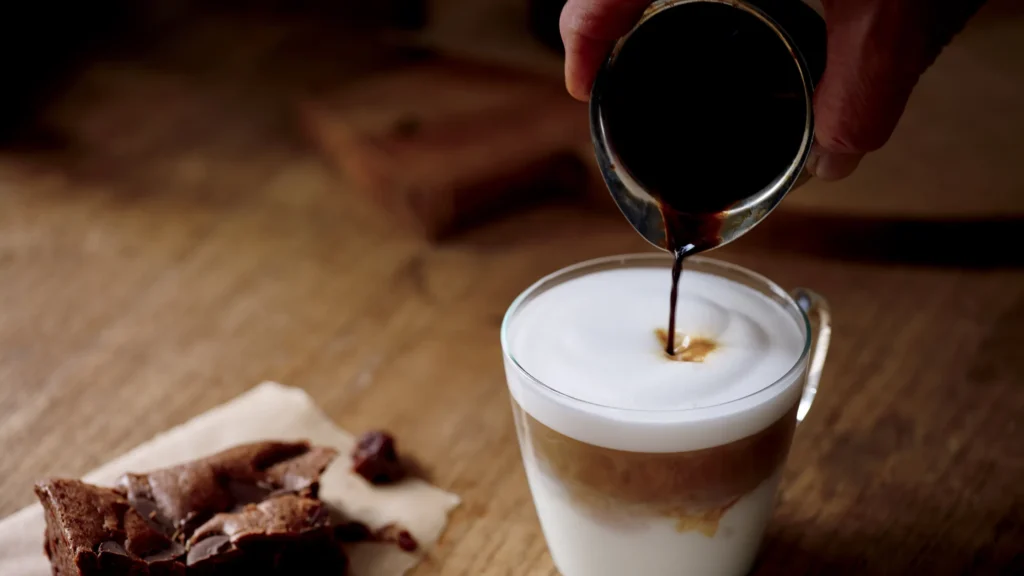
- Flavor Base: The espresso provides the strong coffee flavor that defines a latte. Its intensity balances the creaminess of the steamed milk, creating a harmonious blend of bold and smooth flavors.
- Caffeine Content: Espresso is packed with caffeine, giving the latte its energizing kick. This makes lattes a popular choice for those seeking a morning boost or an afternoon pick-me-up.
- Aromatics and Complexity: The unique brewing process of espresso captures a wide range of aromatic compounds, adding depth and complexity to the latte. Each sip delivers a rich coffee aroma that enhances the overall drinking experience.
- Visual Appeal: The dark, rich color of the espresso creates a beautiful contrast with the steamed milk and milk foam. This visual appeal is one of the reasons why lattes are often enjoyed as a treat in coffee shops.
Milk and Other Additives
While espresso forms the backbone of a latte, the type of milk and various additives play significant roles in customizing this beloved beverage to suit individual preferences.
Types of Milk: The choice of milk can dramatically influence the flavor and texture of a latte. Here are some popular options:
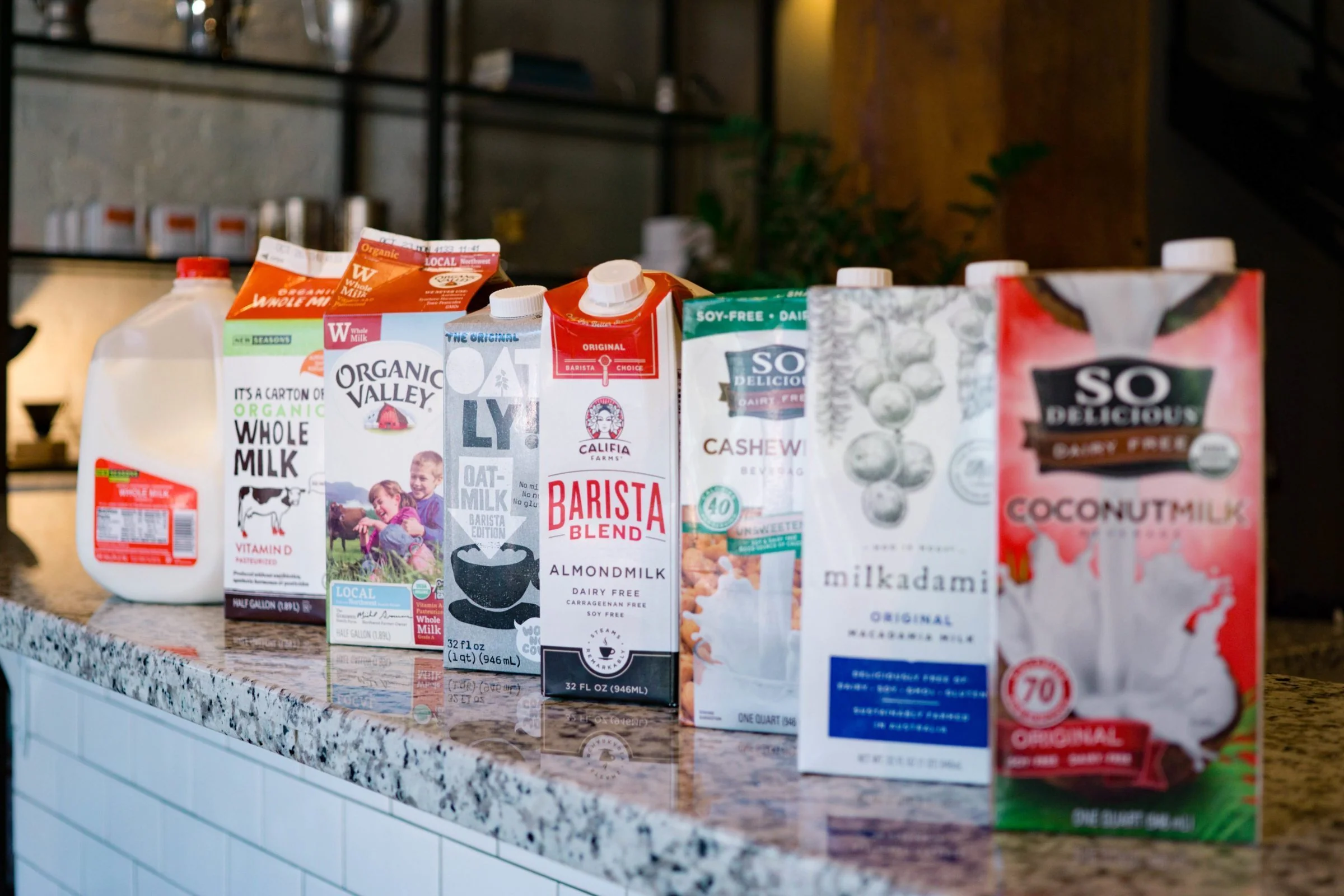
- Whole Milk: This is the traditional choice for lattes, offering a rich and creamy texture that complements the strong espresso flavor. Whole milk creates a smooth, velvety foam that enhances the overall drinking experience.
- Skim Milk: For those looking to reduce their fat intake, skim milk is a good alternative. While it produces a lighter foam and less creamy texture, it still blends well with espresso.
- Non-Dairy Milks: With the rise of dietary preferences and lactose intolerance, non-dairy milks have become popular alternatives. Options include:
- Almond Milk: Provides a nutty flavor and a slightly thinner texture. It’s a popular choice for its low-calorie content and unique taste.
- Soy Milk: Known for its creamy consistency and neutral flavor, soy milk is a versatile option that closely mimics dairy milk.
- Oat Milk: Offers a rich, creamy texture and a slightly sweet flavor. It’s a favorite among those seeking a dairy-free alternative with a similar mouthfeel to whole milk.
- Coconut Milk: Adds a tropical twist with its distinct coconut flavor and creamy texture, making it a unique choice for lattes.
Additives and Flavorings: To further enhance the flavor and personalize a latte, various additives and flavorings can be used:
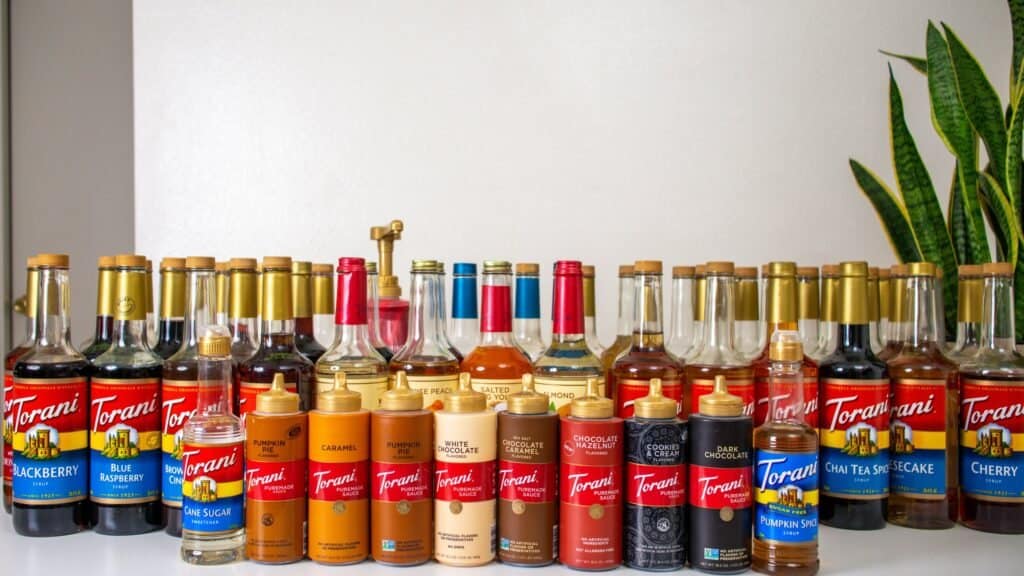
- Sweeteners: Common options include sugar, honey, agave syrup, and flavored syrups (such as vanilla, caramel, or hazelnut). These add sweetness and a new dimension of flavor to the latte.
- Spices: Adding a dash of cinnamon, nutmeg, or cocoa powder can elevate the flavor profile of a latte, providing a warm and aromatic twist.
- Flavor Shots: Many coffee shops offer a variety of flavor shots that can be added to a latte. These include popular choices like mocha, pumpkin spice, and peppermint.
- Whipped Cream: For an indulgent treat, a dollop of whipped cream on top of a latte adds a layer of richness and sweetness.
How to Make a Latte at Home
Making a latte at home can be a rewarding experience, allowing you to customize your drink exactly to your liking. Here’s a step-by-step guide to help you prepare a perfect latte in the comfort of your own kitchen.
Ingredients and Equipment:
- Freshly ground espresso beans
- Milk of your choice (whole, skim, almond, soy, etc.)
- Espresso machine or a stovetop espresso maker
- Milk frother or a steam wand
- A thermometer (optional)
- A spoon
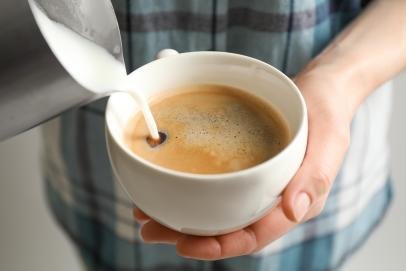
Step-by-Step Guide:
- Prepare the Espresso
- Grind fresh espresso beans to a fine consistency.
- Use your espresso machine or stovetop espresso maker to brew a shot (or two) of espresso. Measure the right grams of coffee for espresso, for a standard latte, you’ll need about 1-2 ounces of espresso.
- Once brewed, pour the espresso into your favorite coffee mug.
- Steam the Milk
- Pour your chosen milk into a stainless steel pitcher. Aim for about 6-8 ounces of milk for a standard latte.
- Use a steam wand to steam the milk, positioning the wand just below the surface to create microfoam. This should take about 20-30 seconds, and the milk should reach a temperature of around 150°F (65°C). If you don’t have a steam wand, you can use a milk frother or even heat the milk on the stovetop, then froth it using a hand frother or whisk.
- Pour the Milk
- Gently tap the pitcher on a countertop to remove any large bubbles in the milk.
- Slowly pour the steamed milk into the mug with the espresso, holding back the foam with a spoon until the mug is nearly full.
- Finally, spoon the remaining foam onto the top of the latte.
- Add Finishing Touches (Optional)
- If you like, you can add sweeteners, flavored syrups, or a sprinkle of cinnamon, cocoa powder, or nutmeg on top of the foam.
- For an extra touch of flair, try your hand at latte art by pouring the milk in a way that creates designs like hearts or leaves.
Tips for the Perfect Latte:
- Use fresh, high-quality espresso beans for the best flavor.
- Ensure your milk is cold before steaming; this helps create better microfoam.
- Practice makes perfect—don’t be discouraged if your first few attempts aren’t barista-quality.
Tools Needed
To create the perfect latte at home, having the right tools is essential. Here’s a list of the necessary equipment and their descriptions to help you get started.
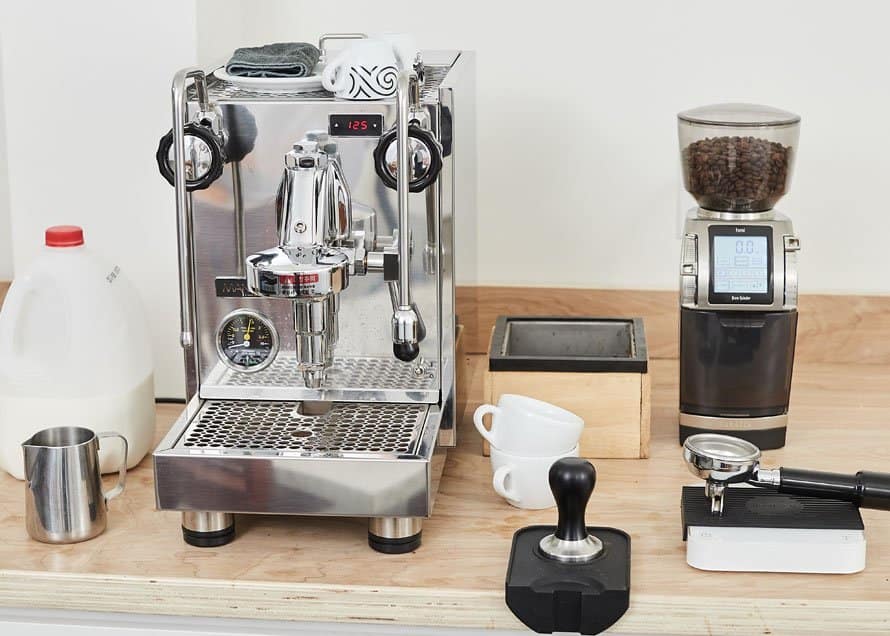
Espresso Machine
An espresso machine is the cornerstone of making a great latte. It brews a concentrated shot of espresso by forcing hot water through finely-ground coffee beans. Look for a machine with a built-in steam wand for steaming milk. There are various models available, ranging from basic manual machines to advanced automatic ones.
Stovetop Espresso Maker (Moka Pot)
If you don’t have an espresso machine, a stovetop espresso maker, also known as a Moka pot, is a great alternative. It brews strong coffee by passing boiling water pressurized by steam through ground coffee. While it doesn’t produce authentic espresso, it creates a similar rich and robust flavor suitable for lattes.
A quality coffee grinder is crucial for freshly ground beans, which provide the best flavor. Burr grinders are preferred over blade grinders as they produce a consistent grind size, essential for making good espresso. Aim for a fine grind for your espresso beans.
Milk Frother or Steam Wand
To create the creamy texture of a latte, you need a way to froth your milk. If your espresso machine has a steam wand, use it to steam and froth the milk. Alternatively, you can use a standalone electric milk frother, which heats and froths the milk automatically. Handheld frothers or manual frothers are also good options if you’re on a budget.
Stainless Steel Pitcher
A stainless steel pitcher is used to steam and froth the milk. Its shape and material make it ideal for creating microfoam and pouring milk smoothly into the espresso. Look for a pitcher with a spout, which is helpful for pouring latte art.
Thermometer (Optional)
While not strictly necessary, a thermometer can help you achieve the perfect milk temperature. Steamed milk should ideally be around 150°F (65°C). Overheating the milk can scorch it, while underheating it won’t create the right texture.
Tamper
A tamper is used to compress the ground coffee into the portafilter basket of the espresso machine. This ensures an even
and consistent extraction, which is key to making a good shot of espresso. Tampers come in various sizes, so make sure to choose one that fits your portafilter.
Spoon
A spoon is handy for holding back the foam while pouring steamed milk into the espresso, ensuring a smooth, creamy blend. It can also be used for adding any finishing touches or stirring in sweeteners.
The Brewing Process
Brewing the perfect espresso for a latte is a precise process that requires attention to detail. Here’s a step-by-step guide to help you master the art of brewing espresso at home.
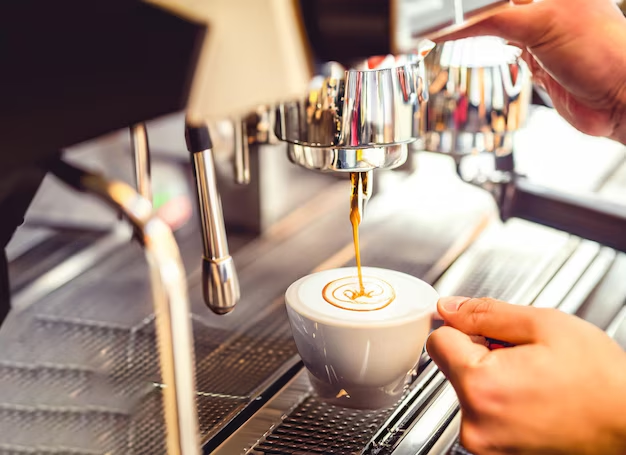
1. Measure and Grind the Coffee Beans
- Measure: Start by measuring out the coffee beans. For a single shot of espresso, you’ll need about 18-20 grams of coffee beans.
- Grind: Use a burr grinder to grind the beans to a fine consistency. The grind size should be finer than table salt but not as fine as powdered sugar. Consistency is key to a balanced extraction.
2. Prepare the Portafilter
- Dosing: Place the ground coffee into the portafilter basket. Make sure the grounds are evenly distributed.
- Tamping: Use a tamper to compress the coffee grounds firmly and evenly. Apply consistent pressure to create a level, compact puck. This step is crucial for even extraction.
3. Preheat the Machine
- Ensure your espresso machine is properly preheated. This includes both the machine itself and the portafilter. Running a blank shot (without coffee) through the machine can help preheat the portafilter and group head.
4. Brew the Espresso
- Lock in the Portafilter: Insert the portafilter into the group head of the espresso machine and lock it in place.
- Start the Extraction: Start the extraction process. Aim for a brew time of around 25-30 seconds for a single shot of espresso. The flow of espresso should be steady and smooth, resembling warm honey in consistency.
- Monitor the Brew: Watch for the espresso to transition from dark to a golden-brown color with a crema (the light, frothy layer on top). If the extraction is too fast or too slow, adjust the grind size or the tamping pressure accordingly.
5. Serve the Espresso
- Once the espresso is brewed, immediately pour it into your pre-warmed coffee cup or mug. This ensures the espresso retains its optimal flavor and temperature.
Tips for Perfect Espresso:
- Fresh Beans: Always use freshly roasted and ground coffee beans for the best flavor.
- Clean Equipment: Keep your espresso machine and tools clean to avoid any residual flavors affecting your espresso.
- Practice: Brewing the perfect espresso takes practice. Don’t be discouraged by initial attempts; consistency will improve with experience.
Common Questions About Lattes
Lattes are a beloved coffee drink, but they often come with a few common questions. Let’s address some of these queries to enhance your understanding and appreciation of this popular beverage.
1. What are the Variations of Lattes?
Lattes are incredibly versatile and can be customized in numerous ways. Here are some popular variations:
- Flavored Lattes: These include the addition of flavored syrups, such as vanilla, caramel, hazelnut, or mocha. These syrups add sweetness and unique flavor profiles to the standard latte.
- Iced Lattes: Perfect for warm weather, iced lattes are made by combining espresso with cold milk and ice. They can also be flavored just like hot lattes.
- Seasonal Lattes: Many coffee shops offer special lattes that reflect seasonal flavors, such as pumpkin spice in the fall or peppermint in the winter.
- Alternative Milk Lattes: For those with dietary restrictions or preferences, lattes can be made with a variety of non-dairy milks, including almond, soy, oat, and coconut milk. Each type of milk offers a distinct flavor and texture.
2. How Much Caffeine is in a Latte?
The caffeine content in a latte primarily depends on the amount of espresso used. Here’s a general breakdown:
- Single Shot Latte: A single shot of espresso, which is about 1 ounce, typically contains around 63 milligrams of caffeine. This is the standard amount used in most small or regular-sized lattes.
- Double Shot Latte: A double shot of espresso, or 2 ounces, contains approximately 126 milligrams of caffeine. This is common in larger lattes or for those who prefer a stronger coffee kick.
It’s important to note that the caffeine content can vary slightly depending on the type of coffee beans and the brewing method.
3. Are Lattes Healthy?
Lattes can be a part of a balanced diet, but their nutritional value depends on the ingredients used. Here are a few considerations:
- Calories and Fat: Lattes made with whole milk are higher in calories and fat compared to those made with skim milk or non-dairy alternatives. Choosing low-fat or plant-based milks can reduce the calorie and fat content.
- Sweeteners: Adding flavored syrups and sweeteners increases the sugar content. Opt for sugar-free syrups or limit the amount of added sugar to make your latte healthier.
- Nutritional Benefits: Milk, whether dairy or non-dairy, provides essential nutrients like calcium, vitamin D, and protein. A latte can contribute to your daily nutrient intake, especially if you choose fortified non-dairy milks.
4. Can I Make Latte Art at Home?
Yes, with practice and the right tools, you can create beautiful latte art at home. The key is to achieve the right milk texture and pouring technique. Start with basic designs like hearts and leaves, and as you gain confidence, you can try more intricate patterns. A stainless steel pitcher with a narrow spout can help you pour with precision.
Variations of Lattes
Lattes are loved worldwide, with each region adding its own twist. Flavored lattes are incredibly popular, often featuring vanilla, caramel, or chocolate syrups to enhance the traditional latte. Iced lattes, perfect for hot weather, combine espresso with cold milk and ice, often flavored similarly to their hot counterparts. Seasonal lattes like Pumpkin Spice and Peppermint Mocha bring festive flavors to the menu during specific times of the year.
For those with dietary preferences or lactose intolerance, alternative milk lattes offer unique flavors and textures. Almond, soy, oat, and coconut milk are popular choices, each adding its distinct taste to the latte. Cultural variations also shine, such as the Japanese Matcha Latte with its earthy, slightly sweet green tea flavor, the spiced Chai Latte from India, and the vibrant Turmeric Latte known for its anti-inflammatory properties.
Caffeine Content in Lattes
Understanding the caffeine content in lattes helps manage intake. A standard latte usually contains one or two shots of espresso. A single shot provides around 63 milligrams of caffeine, while a double shot doubles that to 126 milligrams. This allows customization based on caffeine preference.
Compared to other coffee drinks, an 8-ounce cup of drip coffee has about 95 milligrams of caffeine, while an Americano matches the latte’s caffeine content depending on the number of espresso shots. Cappuccinos and flat whites have similar caffeine levels to lattes. Factors such as bean type, serving size, and brewing method also influence caffeine content.
Managing caffeine intake can be achieved by adjusting the number of espresso shots, opting for smaller sizes, or choosing decaffeinated options. Lattes offer a customizable experience, blending rich, creamy flavors with the perfect caffeine kick to suit individual preferences.
Disclosure: Our blog contains affiliate links to products. We may receive a commission for purchases made through these links. However, this does not impact our reviews and comparisons. We try our best to keep things fair and balanced, in order to help you make the best choice for you.

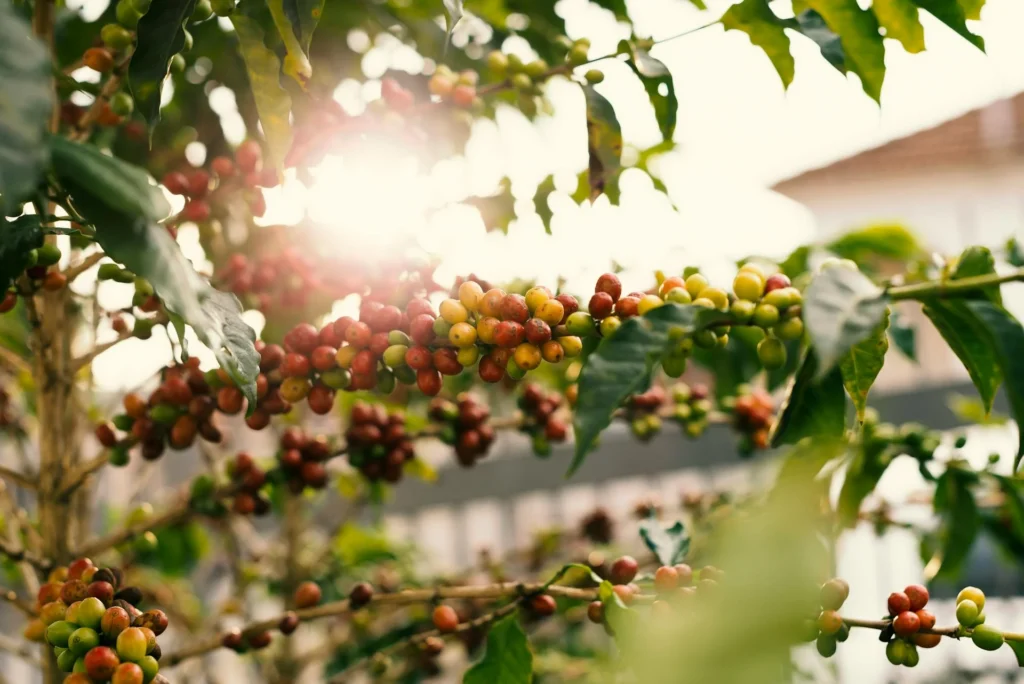
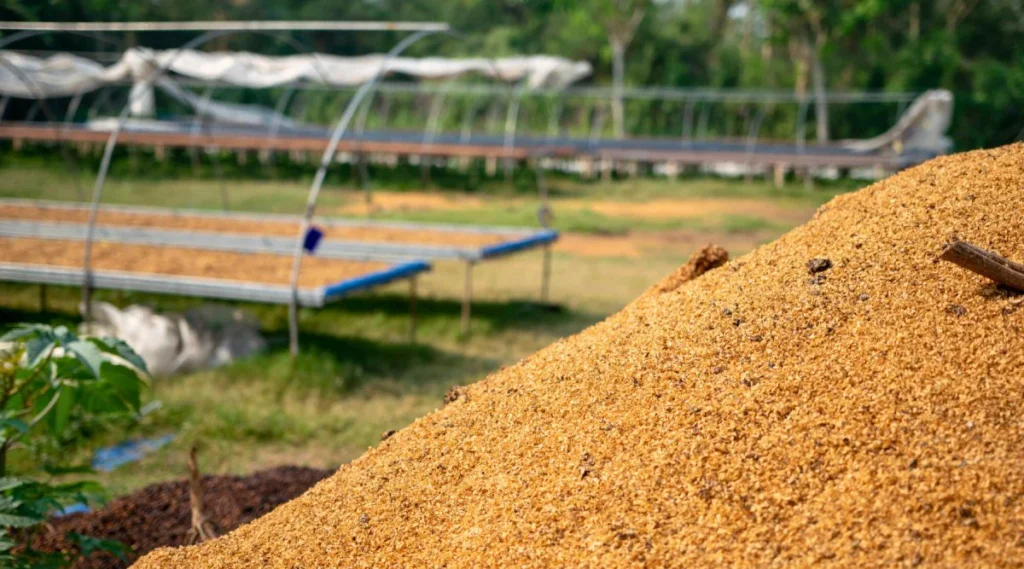
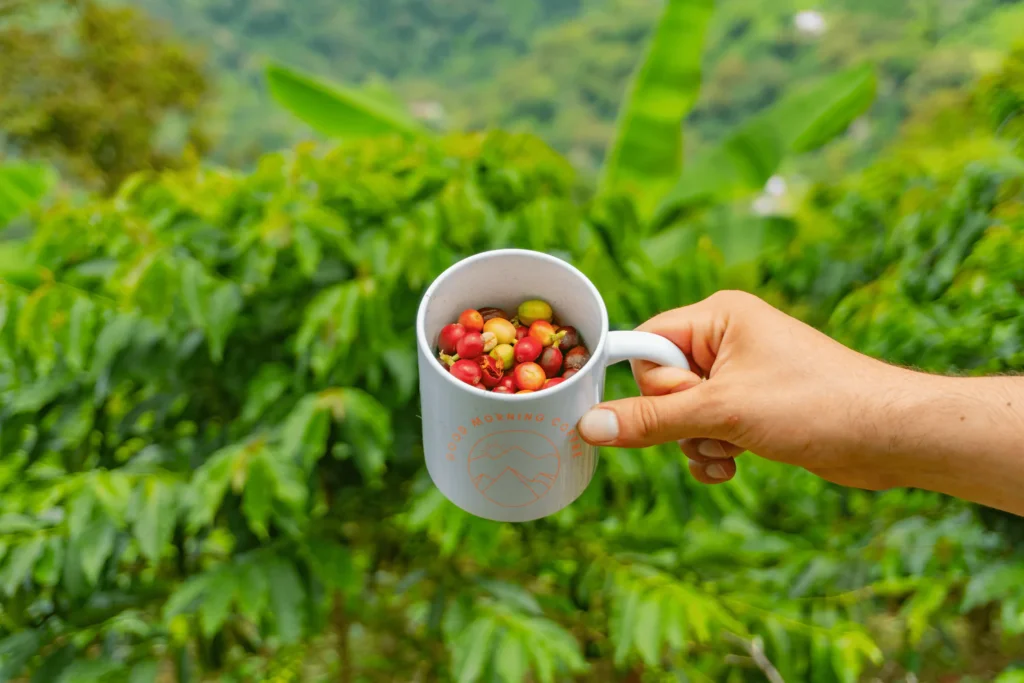

One Response